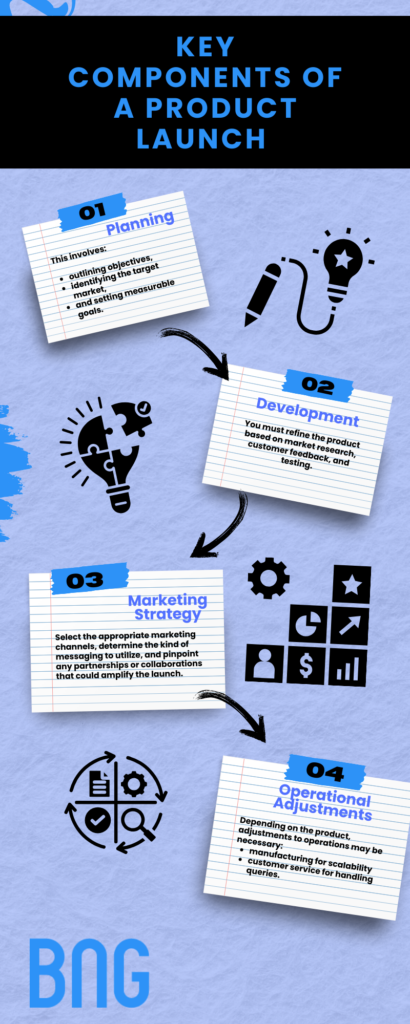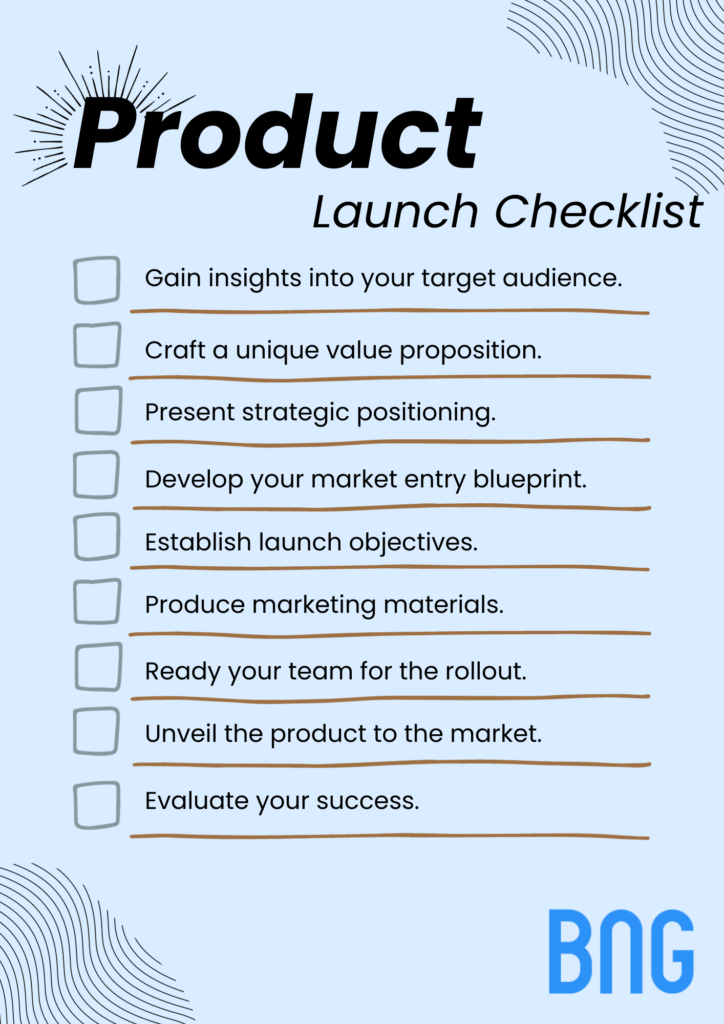A product launch is a strategically organized initiative that introduces a new product or service into the market. The primary objectives for the product launch are to generate buzz and raise public awareness about the businesses’ latest product.
Executing a successful product launch involves seamless collaboration among multiple departments. This includes not only the sales and customer service teams but also product development, marketing specialists, event coordinators, and managerial staff. The comprehensive involvement of these diverse teams ensures that every aspect of the launch—from development to sales to customer engagement—is expertly handled for optimal market impact.
What is a Product Launch?
When we talk about launching a new product, we’re referring to much more than just making a new product available for purchase. A product launch is a multifaceted process that entails the strategic coordination of various elements, designed to introduce a new product to the market and ensure its success in the long run.
Key Components of a Product Launch:
- Planning: This involves outlining your objectives, identifying your target market, and setting measurable goals.
- Development: You must refine the product based on market research, customer feedback, and testing, ensuring it meets a genuine need and adheres to quality standards.
- Marketing strategy: This encompasses choosing the marketing channels to use, the type of messaging to employ, and identifying any partnerships or collaborations that can enhance the launch.
- Operational adjustments: Depending on the product, adjustments to operations may be necessary — from manufacturing for scalability to customer service for handling queries related to the new product.

Types of Product Launches
Understanding the different types of product launches can help you tailor your strategy to your specific circumstances, market, and product. Here’s an exploration of various types of product launches:
Soft Launch
In a soft launch, the product is introduced to a limited audience for real-world testing and feedback. This can be beneficial for tech products or services where it’s crucial to troubleshoot and fix any potential issues before a broader release. For instance, many mobile apps have a soft launch in smaller markets before being introduced globally.
Hard Launch
A hard launch is what most people traditionally consider a product launch—where the product is made available to the public on a large scale, often accompanied by significant marketing and promotional efforts. Hard launches are commonly used for consumer goods where there is already a proven demand, and the focus is on capturing market share quickly.
Rolling Launch
In a rolling launch, the product is released in stages. This could be segmented by different target markets, geographical areas, or even product versions. Rolling launches are often used for products that require localized adaptations or for companies that want to manage inventory or production issues.
Pre-Launch
In a pre-launch strategy, pre-orders for the product are taken before the official launch date. This not only generates excitement and anticipation but also provides an initial influx of revenue that can be useful for scaling production. Video games, books, and even cars have successfully used pre-launch strategies.
Product Launch Examples
Apple’s iPhone
Launched in 2007, Apple’s iPhone revolutionized the smartphone market. The company took a holistic approach to the product launch, covering all the bases—from cutting-edge technology and design to a marketing campaign that generated immense consumer anticipation. The well-timed, well-executed launch resulted in the iPhone becoming a game-changer in the mobile technology.
Tesla Model 3
When Tesla launched its Model 3 in 2017, it took a different approach by utilizing a pre-order model. This created a massive wave of consumer interest and media coverage well before the actual car was available. The strategy allowed Tesla to gauge demand and even generate initial capital to support further production.
Google Chrome
When Google Chrome was launched in 2008, it faced fierce competition from established players like Internet Explorer and Firefox. Google differentiated Chrome by emphasizing its speed, simplicity, and security. A unique approach was their use of a comic book to explain the technical complexity of the browser in an easy-to-understand format. The launch was a tremendous success, and Chrome is now one of the most widely used web browsers globally.
What is the Best Time to Launch a New Product?
The timing of a product launch can make or break its success. Let’s delve into the critical timing factors you must consider to launch a product:
Market Readiness
It is critical to understand whether the market is ready for your product. A product that is too revolutionary may require an extensive consumer education phase, delaying ROI. Conversely, a product that’s late to a saturated market might struggle to gain a foothold.
Seasonality
The time of year can greatly impact your product’s success. For example, launching a new swimsuit line in the middle of winter may not generate as much attention as launching it closer to summer.
Business Milestones
Aligning your product launch with other significant business events, such as anniversaries or participation in major industry expos, can provide additional publicity and leverage broader marketing initiatives.
Competitive Landscape
Finally, keep an eye on what your competitors are doing. If you’re aware that a competitor is planning a similar product launch, consider how your timing can give you a strategic advantage. Do you go to market before them to become the trailblazer or launch afterward to capitalize on their educational marketing?
What is Included in a Product Launch?
A product launch is a planned and executed strategy that includes various stages and components. Here’s a breakdown:
Market Research
Before even developing a product, understanding your market is crucial. Market research allows you to gauge consumer needs, market demand, and even product positioning. You need to answer questions such as:
- What problem is your product solving?
- Who are your competitors?
- What segment of the market are you targeting?
Product Development
Based on the insights gathered from your market research, the product then goes through several iterations. This involves designing, prototyping, testing, and refining the product to ensure it meets customer needs and quality standards. Product development is a dynamic process that can evolve based on consumer feedback and testing results.
Marketing Strategy
A well-planned marketing strategy defines how the product will be introduced to the market. This includes deciding on the marketing mix—the four Ps (Product, Price, Place, Promotion)—and outlining a campaign that could involve various media, ranging from social media to print and TV advertisements.
Promotion
Promotion encapsulates all the advertising and public relations activities undertaken to create buzz around your product. This can include everything from influencer partnerships and press releases to digital marketing campaigns and in-store promotions.
Distribution
No product can be successful if it doesn’t reach the consumer. Distribution involves the logistics and supply chain management necessary to deliver the product to the market. This includes inventory management, shipping, and even choosing the right retail partners.
Post-Launch Assessment
The work isn’t over once the product is launched. A crucial component is the post-launch assessment, where you evaluate the performance metrics, such as sales, customer engagement, and market penetration. Based on this data, further refinements can be made to either the product or the marketing strategy.
And if you’re thinking about launching your own product and need a name for it, then you must check out our product name generator. In just a few simple steps, you’ll have thousands of product names available and ready to register if needed.
Product Launch Checklist
Now you know what’s needed for a product launch, make sure to tick off the items from our checklist:
- Gain insights into your target audience.
- Craft a unique value proposition.
- Present your strategic positioning to key decision-makers.
- Develop your market entry blueprint.
- Establish launch objectives.
- Produce marketing materials.
- Ready your team for the rollout.
- Unveil the product to the market.
- Evaluate your success against pre-defined benchmarks.

Tips for a Successful Launch
Launching a product isn’t just about making it available; it’s about launching it successfully. Here are some tips to help you achieve that:
Know Your Audience
Tailor your messaging to suit your target demographic. Whether you’re focusing on millennials, parents, or corporations, your marketing language and channels should resonate with your intended audience.
Build Hype
Creating anticipation is a surefire way to hit the ground running when your product finally launches. Utilize social media campaigns, influencer partnerships, and even traditional media where appropriate to generate buzz.
Quality Assurance
Nothing can damage a new product’s reputation faster than quality issues. Prioritize comprehensive testing phases, be it through a soft launch or beta testers, to troubleshoot problems before the general release.
Follow Up
Success doesn’t end when your product hits the market. Monitor metrics like sales, customer feedback, and online engagement to evaluate what’s working and what isn’t. Make data-driven decisions to refine and adapt your post-launch strategy accordingly.
Key Takeaways
A successful product launch is a multi-faceted endeavor that requires meticulous planning, timing, and execution. With the right strategies, even the most modest of products can turn into market leaders. Your launch strategy should be as innovative as the product itself, leveraging timing, market research, and robust marketing tactics to ensure not just a successful launch but also long-term product viability.
Overall, don’t underestimate the importance of a well-executed product launch—it’s not just about getting your product out there but making sure it thrives in a competitive market landscape.